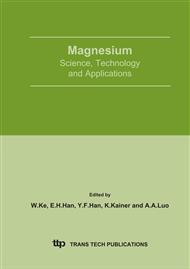p.25
p.31
p.35
p.39
p.43
p.49
p.53
p.57
p.61
Recent Technological Advancement and Developmental Trend of Pidgeon Process in Smelting Magnesium in China
Abstract:
The crude magnesium is produced mainly by Pidgeon Process in China. Although Pidgeon Process has achieved certain technological advance in the past ten years, it is mainly by sacrificing energy, environment, and cheap labor. In the 21st century, human activities should be energy-saving and environment friendly. The equipment used in the Pidgeon process should be improved as early as possible by elevating its automatic level in order to save energy, protect the environment and realize scale economy of magnesium production. This will be the developmental trend of Pidgeon process in smelting magnesium.
Info:
Periodical:
Pages:
43-48
Citation:
Online since:
July 2005
Authors:
Keywords:
Price:
Сopyright:
© 2005 Trans Tech Publications Ltd. All Rights Reserved
Share:
Citation:


